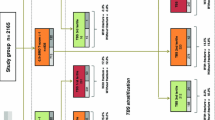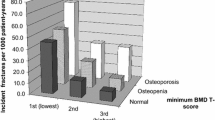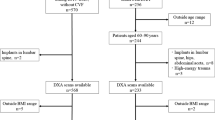Abstract
This case–control study assessed whether the trabecular bone score (TBS), determined from gray-level analysis of DXA images, might be of any diagnostic value, either alone or combined with bone mineral density (BMD), in the assessment of vertebral fracture risk among postmenopausal women with osteopenia. Of 243 postmenopausal Caucasian women, 50–80 years old, with BMD T-scores between –1.0 and –2.5, we identified 81 with osteoporosis-related vertebral fractures and compared them with 162 age-matched controls without fractures. Primary outcomes were BMD and TBS. For BMD, each incremental decrease in BMD was associated with an OR = 1.54 (95% CI = 1.17–2.03), and the AUC was 0.614 (0.550–0.676). For TBS, corresponding values were 2.53 (1.82–3.53) and 0.721 (0.660–0.777). The difference in the AUC for TBS vs. BMD was statistically significant (p = 0.020). The OR for (TBS + BMD) was 2.54 (1.86–3.47) and the AUC 0.732 (0.672–0.787). In conclusion, the TBS warrants a closer look to see whether it may be of clinical usefulness in the determination of fracture risk in postmenopausal osteopenic women.

Similar content being viewed by others
References
NIH Consensus Development Panel on Osteoporosis Prevention Diagnosis and Therapy (2001) Osteoporosis prevention, diagnosis, and therapy. JAMA 285:785–795
Davies KM, Stegman MR, Heaney RP, Recker RR (2005) Prevalence and severity of vertebral fracture: the Saunders County Bone Quality Study. Osteoporos Int 6:160–165
Vogt TM, Ross PD, Palermo L, Musliner T, Genant HK, Black D, Thompson DE (2000) Vertebral fracture prevalence among women screened for the fracture intervention trial and a simple clinical tool to screen for undiagnosed vertebral fractures. Mayo Clin Proc 75:888–896
Johnell O, Kanis JA, Oden E, Johansson H, De Laet C, Delmas P, Eisman JA, Fujiwara S, Kroger H, Mellstrom.D., Meunier PJ, Melton LJ3, O’Neill T, Pols H, Reeve J, Silman A, Tenenhouse A (2005) Predictive value of BMD for hip and other fractures. J Bone Miner Res 20:1185–1194
WHO Study Group (1994) Assessment of fracture risk and its application to screening for postmenopausal osteoporosis [Report of the WHO Study Group]. WHO Tech Rep Ser 843:1–129
Hordon LD, Raisi M, Paxton S, Beneton MM, Kanis JA, Aaron JE (2000) Trabecular architecture in women and men of similar bone mass with and without vertebral fracture: part I. 2-D histology. Bone 27:271–276
Rice JC, Cowin SC, Bowman JA (1988) On the dependence of the elasticity and strength of cancellous bone on apparent density. J Biomech 21:155–168
Link TM, Majumdar S (2004) Current diagnostic techniques in the evaluation of bone architecture. Curr Osteoporos Rep 2:47–52
Rubin CD (2005) Emerging concepts in osteoporosis and bone strength. Curr Med Res Opin 21:1049–1056
Sawada K, Morishige K, Ohmichi M, Nishio Y, Yamamoto T, Hayakawa J, Mabuchi S, Isobe A, Sasaki H, Sakata M (2003) Peripheral quantitative computed tomography (pQCT) is useful for monitoring bone mineral density of the patients who receive hormone replacement therapy. Maturitas 56:343–349
Pothuaud L, Carceller P, Hans D (2008) Correlations between grey-level variations in 2D projection images (TBS) and 3D microarchitecture: applications in the study of human trabecular bone microarchitecture. Bone 42:775–787
Pothuaud L, Barthe N, Isidore MP, Carceller P, Hans D (2008) Validation of a 2D/3D generic mathematical relationship between TBS as assessed by DXA, and BV/TV and TbTh as assessed by micro computed tomography: an experimental study based on human cadaver vertebrae. Proceedings, 30th Meeting of ASBMR, Montreal, p 194
Pothuaud L, Barthe N, Krieg M-A, Mehsen N, Carceller P, Hans D (2009) Evaluation of the potential use of TBS to complement BMD in the diagnosis of osteoporosis: a preliminary spine BMD-matched, case-control study. J Clin Densitometry 12(2):170–176
Genant HK, Jergas M, Palermo L, Nevitt M, Valentin RS, Black D, Cummings SR (1996) Comparison of semiquantitative visual and quantitative morphometric assessment of prevalent and incident vertebral fractures in osteoporosis: the study of Osteoporotic Fractures Research Group. J Bone Miner Res 11:984–996
Rabier B, Winzenrieth R, Héraud A, Grand-Lenoir C, Pothuaud L, Hans D (2009) A multicentre, retrospective case-control study assessing the role of trabecular bone score (TBS) in a cohort of menopausal Caucasian women with low bone mineral density (BMD): analysing the risk of vertebral fracture. Bone (in press)
Acknowledgment
This study was supported by Medimaps SA, Bordeaux, France.
Author information
Authors and Affiliations
Corresponding author
Rights and permissions
About this article
Cite this article
Winzenrieth, R., Dufour, R., Pothuaud, L. et al. A Retrospective Case–Control Study Assessing the Role of Trabecular Bone Score in Postmenopausal Caucasian Women with Osteopenia: Analyzing the Odds of Vertebral Fracture. Calcif Tissue Int 86, 104–109 (2010). https://doi.org/10.1007/s00223-009-9322-y
Received:
Accepted:
Published:
Issue Date:
DOI: https://doi.org/10.1007/s00223-009-9322-y




